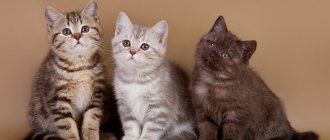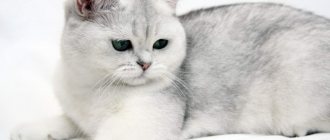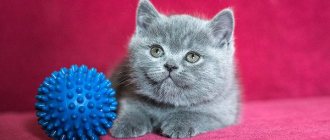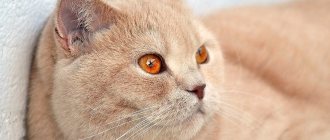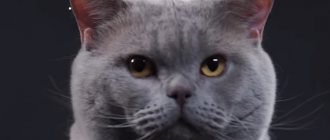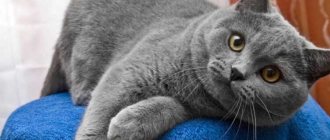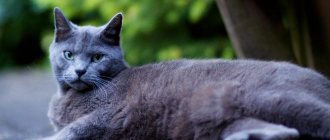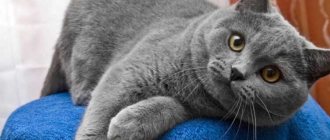- Pets
- >>
- Cat breeds
* Here is a photo of a typical representative of the British Shorthair cat breed . You can send us photos of your animals by email, and we will post them on the website. Don't forget to send your pet's name.
Video
* We invite you to watch a video about the British Shorthair cat . In fact, in front of you is a playlist in which you can select and watch any of 20 videos about a given cat breed by simply clicking on the button in the upper right corner of the window. In addition, the material contains quite a lot of photos. By looking at them you can find out what a British Shorthair cat looks like.
In this article:
|
History of the origin of British Shorthair cats
Representatives of felinology still cannot agree on the origin of British cats.
Today there are two main versions, each of which has its own list of supporters:
- France. Many felinologists believe that the history of the British is closely connected with their fellow French - the Chartreuse cat breed. According to scientists, representatives of these groups were brought to Europe from Africa at approximately the same time. The new breed was first bred by monks. Cats came to Britain through ships, where they served as rat catchers. This theory is confirmed by the similarity between the British and the Chartreuse;
- Rome. Delving into history, you can find interesting facts about the conquest of Britain by Rome. It is with this event, according to felinology scientists, that the emergence of this breed on British soil is connected. Felinologists believe that the Romans brought Roman cats to Britain, which, in turn, quickly adapted to the new land and were loved by its settlers. This version of origin is confirmed by numerous mass graves of cats that were discovered by archaeologists in Britain.
Only one thing can be said with certainty: the real history of cats began in Britain. It is here that the earliest depictions of British Shorthairs were discovered, dating back to around the 700s. Small pictures of animals were applied to colored miniatures.
Interesting fact: There were images of representatives of this breed in books. So, in the 800s, in a handwritten book, one of the Irish monks drew a British shorthair cat and wrote that such an animal really brightens up the monastic everyday life, making them more interesting.
In the 10th century, the cult of the British only increased. At this time, the Celtic sculptor, when creating a stone cross with scenes from the Passion of Christ, did not forget to add cats. One had a small kitten in his paws, and the other had a chick. Around the same time, a law was passed in Britain to protect cats. Representatives of this breed were very expensive.
British Shorthair cat - description of the breed
British shorthair cats are the most ancient representatives of large cats. The original name of the breed was “British Blue”. This is due to the peculiarity of the pet’s iridescent color. The new name is also associated with wool, only this time not with color, but with length: “Shorthair”.
The British are quite strong and robust pets, characterized by medium and large dimensions.
The main descriptive features of the body structure are:
- Round head, widened at the cheekbones. The neck of cats is very thick (almost invisible), but at the same time short;
- Expressive muzzle. The nose is short and straight. He is vertical with a strong chin;
- Big eyes. The look is one of the main characteristics of the British. The eyes of these cats are large, wide open and set far apart. They can be orange or blue. The shade of the eyes depends on the color of the animal;
- Squat body. The body of the animals is straight, the back is short, and the shoulders are massive;
- Short legs. At the same time, cats’ paws are very strong and large;
- Thick tail. This part of the cat's body is not very long. The tail is rounded at the end;
- Thick and short fur. The most important feature of animals of this breed. The British coat is shiny, medium soft/hard and has a dense texture.
In general, representatives of the British Shorthair look very attractive and graceful. It was their appearance that became the reason for the increased love for them from people. What attracts most about the British is their look and fluffy big cheeks, which children love to squeeze.
Average whole adult: 6-9 kg (males) and 4-6 kg (females). Height at the withers is 28-33 cm. The life expectancy of pets is 15-20 years. This period largely depends on the Briton’s habitat, conditions of detention, nutrition and treatment. Animals need regular vaccinations and a special menu. Moreover, they can be kept both indoors and outdoors.
Popular colors of British Shorthair cats
Initially, almost all British cats had a gray-blue color (which is what their first name is associated with). During the selection process, the colors of the animals changed. Today, more than 100 types of British colors are known.
The most popular and frequently encountered of them are the following pattern options:
- Solid. In this case, the animal’s fur is completely painted in one specific color. Most often, the British have blue, gray-blue, black, silver, tabby shades;
- Smoky. This coloring is based on the contrast between the undercoat (as light as possible) and the coat itself (tips as dark as possible). The legs, back and head will be the darkest. The muzzle and legs themselves have practically no markings. This color is characterized by orange (copper) eyes;
- Bicolors. The coat of representatives of this color combines two shades: the main one (tortoiseshell/solid) and white. At the same time, the light part of the body is clearly separated from the dark part and has no hairs of any other shade (than white);
- Tortoiseshell. This color implies two or more shades that are similar to each other (blue and cream, red and black). Tortoiseshell coloring refers to the so-called spots on animal fur;
- Tabby. A color in which spots are clearly visible on the cat’s body: on the forehead in the shape of the letter “M”, on the back there are clear lines along the spine, on the chest there are continuous rings, the belly is spotted. This color is also called marbled, tacked, striped and spotted;
- Colorful. A color that implies the presence of a white “cloak” (on the body). With colorful coloring, only some parts of the body are actually colored: tail, paws, muzzle. An interesting fact is that this color can change due to temperature changes.
The presented classification is general. Due to selection, other shades can be obtained. However, only British dogs whose color is recognized and acceptable are allowed to take part in shows.
Character and habits of British Shorthair cats
British shorthair cats are quite peculiar animals. They are very calm and flexible, but at the same time they treat others in a special way. The British have their own attitude towards their owners. And, if there is a representative of this breed in the house, then he is the owner.
The character of cats is very aristocratic (which is fully explained by the history of their origin). Animals are independent, arrogant and majestic. If you are looking for a pet that will constantly cuddle, ask to be held and purr, throw away the idea of buying a Briton. Such animals will not rub against you even if they are very hungry. The only action they will take when hungry is to sit next to an empty bowl.
Interesting fact: British Shorthairs do not like to be held or cuddled for long periods of time. However, they will happily settle down somewhere on the bed next to their owner. But only of your own free will!
In general, the nature of the animals is peaceful and calm. The British rarely tear their throats out with meows or run around the house out of boredom. Most often they can be found sleeping, eating, or languidly looking out the window. Animals are a little withdrawn, but quickly make contact with people (naturally, only with those they like). British Shorthair cats especially love children.
At the same time, kittens (under the age of one year) play well with their little owners, but are capable of inadvertently biting or scratching their “friend.” British adults simply tolerate all the antics of the children and pay practically no attention to it (unless you pull the pet by the tail).
British Shorthair cats can easily withstand solitude. They are waiting for their owner from work and are extremely happy about his return. Such pets are best suited for constantly busy or lonely people. Animals are wary of strangers. To trust a new guest, a Briton needs to take a good look at him. But there is only one way to make friends between a cat and a new pet - leaving them alone in the apartment for at least a day (while you are at work).
Do the British have bad habits?
In most cases, as experienced British breeders note, the appearance of negative habits in an animal is associated with improper upbringing. Inexperienced pet owners should remember what actions the animal needs to be weaned from immediately.
- Throw objects from high surfaces to watch them fall. An extremely unpleasant habit, which the owner does not pay attention to at first, as unbreakable objects fall, but then they are replaced by vases, flower pots, and photo frames. There is no need to panic, just treat the surface where the Briton likes to play pranks several times. Any product that cats hate is suitable for this - citrus fruits or special products that can be bought at a pet store or veterinary pharmacy.
- Scratching and biting a person's hands. This happens especially often in kittens at 4 months of age, when their teeth change. It is better to offer your four-legged friend a scratching post or special toys on which to sharpen their fangs and claws.
- Love for other people's bags and packages. Although this habit is considered negative by breeders, it does not require adjustment. Often a cat can be found not only in bags belonging to friends and acquaintances, but also in bags and boxes of new shoes.
- Choosing an unusual item for the game. Unfortunately, in this case, the owner has only one correct decision - to allow him to play, since after 1-2 days the animal will forget about it.
Interesting facts about British Shorthair cats
British shorthair cats are already unusually amazing and fascinating in themselves. Therefore, it is not at all strange that there are many facts that only increase the interest of pets.
Here are a few as examples:
- British cats are independent from people (as they believe). They choose for themselves who will be their friend and who they will never let close to them;
- There are no lop-eared Britons. You can often find the name “British Fold”. It is completely false. Only Scots can have long-eared or straight-eared ears. The British come in short- and long-haired varieties;
- British Shorthairs do not require special care for their coat. The molting of these animals is less problematic than the molting of their close relatives;
- The British have their own opinion on any issue. They need to be raised from early childhood - otherwise the cat will really become the master of the house;
- Animals are not afraid of loneliness. They can remain alone with themselves even for several days. The main thing is to always have a filled bowl nearby;
- According to one version, the image of the Cheshire cat was copied specifically from representatives of the British breed;
- Britons are one of the most ancient cats on earth. Despite its already venerable age, the breed gained worldwide fame and popularity relatively recently;
- Representatives of the British Shorthair breed are true sleepyheads. For the British, the daily sleep norm is 14-16 hours;
- Nowadays, British Shorthairs mostly decorate homes. Previously, the main task of representatives of this breed was to fight rodents. Therefore, the British have very well developed hunting abilities.
And the final interesting fact about these amazing cats is that the British tabby cat is the official representative of the Whiskas brand!
How to bathe a cat
The British are clean, but they still need to be bathed sometimes. To do this, you must use special tools and follow the following rules:
- the pet should be placed in a basin filled one third with warm water;
- When applying shampoo, you should support the cat under the neck;
- The soap product must be washed completely; a shower and a comb may be useful for this.
After bathing, the animal must be wrapped to dry the fur. When it dries, you can comb it carefully.
Pros and cons of British Shorthair cats
Representatives of this breed have many advantages. The first concerns their unique appearance. The animal's body is graceful, and its gaze is simply piercing. Such a pet will definitely not go unnoticed by guests. The British have other advantages.
The advantages of such cats include:
- Good health (cat's immunity can withstand all tests quite steadfastly);
- Friendliness (the British are absolutely not aggressive, they get along well with others and make contact);
- Cleanliness (cats carefully and scrupulously lick their fur; they should be washed extremely rarely);
- Lack of special care (cats are unpretentious in care, the only thing required from the owner is weekly hair removal).
Among other things, British Shorthairs are very good “healers”. They help their owners cope with depression, stress, and bad mood. Such animals are recommended for adoption in families with children with developmental disabilities. The British will have a positive effect on their psycho-emotional state.
However, not everything is as colorful and beautiful as it seems at first glance. The British also have certain disadvantages.
The main disadvantages of these royal English cats include:
- Special character. Each cat of this breed is special and has its own character. It is almost impossible to guess what kind of pet (playful or sleepy) you are buying. Everything depends on the upbringing and development of certain qualities;
- Standard beauty procedures. The British are purebred cats. And no matter how unpretentious they are in their care, some procedures will still have to be carried out. This applies to regular nail trimming, eye washing, and prophylaxis (vaccinations);
- Feeding. Britons need a balanced diet. You can feed them both premium food and natural food (fish, beef, chicken).
Of course, British cats have many more advantages. That is why they enjoy such high popularity and interest.
Tea dictionary
| Aroma | Aroma |
| Boling water | Boiling water |
| Brew | Welding |
| To brew tea | Brew tea |
| Ceylonese tea | Ceylon tea |
| China | 1) China 2) Porcelain |
| China tea | Chinese tea |
| Cup | Cup |
| Curd | Kurd, custard |
| Darjeeling | Darjeeling (type of tea) |
| Earl Gray | Tea with bergamot |
| Green tea | Green tea |
| Herbal tea | Herb tea |
| Indian tea | Indian tea |
| Kettle | Kettle (for boiling water) |
| Lump (of sugar) | Sugar cube) |
| Milk | Milk |
| Mint tea | Tea with mint |
| Oolong | Ulung (type of tea) |
| Saucer | Saucer |
| To stir | Mix |
| Scone | Scone, classic English muffin |
| Strong tea | Strong tea |
| Sugar | Sugar |
| Taste | Taste |
| Tea house, tea shop | Tea house, teahouse |
| Tea leaves | Tea leaves |
| Tea strainer | Tea strainer |
| Teapot | Teapot, teapot |
| Teaspoon | Tea spoon |
| Weak tea, watery tea | Weak tea |
| White tea | White tea |
Breeding British Shorthair cats
Breeding purebred British dogs is quite a profitable and interesting activity. Breeders are working to increase the number of these cats. Breeding British shorthair cats begins with the purchase of a breeding (i.e. purebred, thoroughbred) individual. The process of finding a partner for an animal is quite long and labor-intensive. In addition to the ideal pedigree, the future parent of the offspring must be completely suitable for the companion. Cats don't always happen the first time.
In addition to the breeder, breeders are also involved in creating British offspring. What is the difference between these specialists? In relation to your business. The former begin breeding only with breeding animals and carefully approach not only the choice of a partner for the cat, but also the owners. The breeders are driven by the desire to earn more money. Most often, they breed non-pedigreed (not purebred) British and pay little attention to where the kids will live in the future.
Important fact: If possible, you should contact the breeder to purchase an animal. Such a person is guaranteed to provide you with a purebred cat, provide full training on its maintenance and provide a documentation package.
The breeding of British Shorthair cats is not regulated by any specific law. This action is allowed in all countries. Animals are bred in accordance with relevant certificates and standards. As a rule, the first mating occurs at the age of 10-12 months (with breeding - 16-20 months). Animals reproduce over a period of 7-8 years.
Attitude towards children
The presence of cats in the house has a very beneficial effect on the development of children. They create a favorable environment and promote the production of “happiness hormones.” Quite often in families with one child, you can hear complaints from parents that the baby is growing up capricious, spoiled, and misbehaving. A furry pet in the house changes the psyche of children for the better.
The animal partially switches the parents' attention from the child to themselves, reducing the intensity of excessive care. The child may begin to talk to the cat, which will help with speech development. By playing with a pet, children develop fine and gross motor skills.
Some psychologists even argue that having an animal in childhood helps you cope more easily with adolescence, and then in family life. Such children, and subsequently adults, are kind, sociable, and treat others with understanding.
It is believed that cats strengthen the baby's immunity. They bring their own microflora, which the baby will encounter outside the home, and make it possible to resist various diseases.
Parents often worry about their child's allergies. Before adopting a pet, consult your doctor. It is believed that children who grew up with animals are less susceptible to allergies.
Caring for British Shorthair cats
British cats are cats that get along well both indoors and outdoors. These cats can be kept in an apartment or private house. The main thing is not to forget in advance (before the kitten arrives in the family) to prepare for it a sleeping place, a tray, a bowl of food. Immediately after the animal enters the house, it is necessary to begin accustoming it to these places.
As stated earlier, British Shorthair cats require little special care. They deal with the problem of dirty fur on their own and lick themselves several times a day.
However, owners should still follow some rules:
- Combing. The coat of the British breed is short, so it is enough to brush it once a week. During the molting period, this procedure should be carried out daily;
- Bathing. Animals should be washed as needed. However, bath procedures should not be carried out more than once a quarter. You can dry wet wool with a hairdryer (low flow of warm air). In this case, the drying process can also occur naturally. The main thing is to completely eliminate the possibility of drafts (they can provoke illness);
- Claws and ears. Every 2-3 weeks, cats need to have their ears cleaned. This should be done using a damp cotton pad. Nails are trimmed at the same frequency. When performing this procedure yourself, you must be especially careful (so as not to touch the vessels). To reduce the frequency of nail trimming, it is enough to install a scratching post at home;
- Veterinary assistance. To maintain the normal condition of the animal, it is necessary to regularly visit the veterinarian, get vaccinations and give vitamins.
In general, caring for the British is not particularly difficult. Animals cope well with some procedures on their own and only need some human assistance. And any deterioration in the condition almost immediately manifests itself externally (deteriorated behavior, increased drowsiness, lack of appetite).
FAQ
We will find out about how long a cat bears kittens, discuss problems. We will tell you about the character of the Persian cat: https://tvoipitomec.com/cats/harakter/persidskaya-koshka-harakter.html, we will find out the details.
It is not at all necessary to specifically engage in raising a Briton. These cats are quite smart and will be able to understand everything they need on their own. Even a tiny kitten is unlikely to go to the toilet anywhere other than the litter tray or sharpen its claws on the owner’s furniture. The sleeping place for a Briton should be located at some elevation and away from drafts. These cats do not experience insomnia, but periods of drowsiness may occur. After eating, a British person will never run around the apartment. He needs a full nap to digest his food.
You should not constantly keep your Briton busy with games or grooming procedures. This is a cat breed for which it is extremely important to get enough sleep. A kitty that doesn't get enough sleep will eat poorly and be lethargic and irritable.
The British cat is an extremely clean creature. She will spend half of her active time on hygiene procedures.
And this has not only a hygienic meaning. In this way, the cat often escapes stress and brings itself into psychological harmony after, for example, a trip to the veterinarian, a trip by transport, catching up with the owner.
Video: character traits of the breed
Pet activity
Up to a year old, little British babies are restless and love outdoor games. In this they are no different from all other kittens. But after reaching the age of one, the activity decreases, and the Briton begins to lead a much more relaxed lifestyle.
Adsense clicker for making money on Google AdSense from 500 to 1000 dollars per month
When a Briton is well-fed and sleepy, he will take advantage of every opportunity to play. Only very old and fat cats do not play. In games, British cats are precise, dexterous, and inventive.
It is especially interesting to watch little kittens play. They endlessly hunt each other down, ambush each other, and race each other.
Interestingly, they accurately imitate the behavior of adult cats: showdown with an opponent, attack, defense, a mother guarding her children, defense of prey, fighting.
When a cat plays, its actions are almost indistinguishable from its behavior in real life. She can hunt for a ball or the owner's hand, like a mouse. But she does not experience such vivid emotions as in a real situation, and her sharp claws are hidden in the soft pads of her paws.
Young Britons can play alone, for example, with a cork, a piece of fur, a ball, or paper that has fallen under their paw. But an adult cat is unlikely to play alone. In order to somehow motivate her to move or be physically active, you need to provide your beloved kitty with a corner where she can hunt and improve in simple acrobatic exercises. And if there is no corner, then you need to pay attention to your pet 2-3 times and play active games with him, including running and jumping.
If a cat is not engaged in controlled play, then it can fulfill its need for movement by rushing around the apartment at breakneck speed and knocking over everything that comes in its way.
At the same time, the cat can jump on tables and cabinets and look for new interesting toys there. It is best to provide the kitty with a sufficient amount of activity so that the game does not go out of control.
We'll tell you about the bump on the cat's stomach and find out the details. Read about the character of the Scottish Fold cat. What are the features?
Good tips, here you will learn about the character of the Abyssinian cat.
Sometimes animals that have not been played with for a long time begin to play hide and seek with their owner and test his patience.
The British are very fond of toys, which must be periodically replaced with new ones so that the kitty does not get tired of them.
Diet of British Shorthair cats
The British are quite voracious pets. Complementary feeding of kittens begins already at 3 weeks of age (not with mother's milk). As soon as the animal becomes more independent, they begin to gradually switch it to wet (canned) food. The transition to dry food is carried out only at 4 months. Most breeders follow this algorithm. Kittens arrive into the hands of new owners already accustomed to food.
There are two ways to feed the British: feed and natural. The first is the simplest, but requires significant investments. Cats can eat dry food all their lives without harm to their health. In this case, you should choose premium mixtures. You cannot save on a new family member. It is not worth feeding an animal if it only eats artificial complementary foods. Of course, a piece of boiled chicken will not kill a cat. But, firstly, its body may malfunction (which will lead to the onset of illness), and secondly, all the microelements necessary for a cat are present in the food - such food is both healthier and more appealing to animals.
If you decide to feed your Briton exclusively natural food, then be prepared to learn the difficult science of “British cooking”.
The animal's basic diet should consist of:
- Meat (low-fat chicken and beef) - boiled, pitted and cut into small pieces;
- Cereals (cats can only have rice, millet, buckwheat, oats) – boiled in the usual way;
- Vegetables (carrots, herbs) – boiled or baked and served as top dressing.
The following foods are strictly prohibited for the British: pork, smoked meats, flour, sausages, and fatty fish. With this method of feeding, it is necessary to observe the ratio of vitamins, microelements, as well as the individual preferences of the animal. Your pet's menu should periodically include boiled eggs, chicken liver, and dairy products. You should not forget about drinking - clean and fresh water should always be in the bowl of a British shorthair cat.
Feeding
By nature, any cat is a predator, so there should be variety in the diet. According to her instincts, she eats the entire portion of food given to her. You should not overfeed your pet to avoid causing problems with digestion and obesity. Lack of activity also affects weight gain.
Food should be either completely natural or ready-made. Mixing them is not recommended by veterinarians and cat breeding specialists. Cats prefer meat and meat products as natural food.
You should not choose fatty meats. You can include milk, kefir, cheese, vegetables, and various cereals in your diet. Special vitamin complexes can be used as supplements. If your cat receives ready-made food, it is better to choose a reliable manufacturer. Economy class food can be harmful to health.
Diseases and health problems
The health of British Shorthair cats is quite good. Proper care and timely vaccination almost completely eliminate the likelihood of diseases. However, some dangers still await animals.
The most common health problems in the UK include:
- Obesity. This disease is associated with the natural large body of animals and their constant desire to eat. Excess weight can occur due to a violation of the pet’s diet, as well as an increase in the daily norm. At the same time, you cannot starve the animal - this can lead to a decrease in activity and loss of natural fluffiness;
- Hypertrophic cardiomyopathy. A hereditary disease, the detection of which dooms the animal to the absence of offspring (transmission of the disease is unacceptable). HCM occurs in adult cats (under 8 years of age) and cannot be treated. Annual cardiac ultrasounds and strict monitoring by a veterinarian help maintain the animal’s condition;
- Conjunctivitis. This disease occurs quite often. Its main symptoms are watery/festering eyes, and its prerequisites are injuries, infections or lack of vitamins. The disease is not fatal and can be treated fairly quickly;
- Gastritis. Inflammation of the stomach may be associated with an incorrectly composed diet of the animal. With such an illness, the cat may vomit, diarrhea and lead an inactive lifestyle;
- Parasites. Foreign living creatures affect not only the animal’s fur, but also its ears, eyes, and gastrointestinal tract. Among parasitic diseases, the most common are helminthiasis, demodicosis, and otodectosis. Regular deworming is used as a preventive measure.
Most (non-genetic) diseases are easily identified and quickly treated. The first signs of a cat's health problems are: lack of appetite, inactivity, vomiting, diarrhea, changes in the structure of the coat. Any of these signs should be a reason to visit a doctor. With timely examination and a correctly prescribed course of treatment, complications can be avoided.
